Tintype Studio
 Without a doubt, the last building Ford added before the October 21, 1929 grand opening of Greenfield Village was the replicated Tintype Studio.
Without a doubt, the last building Ford added before the October 21, 1929 grand opening of Greenfield Village was the replicated Tintype Studio.As Ed Cutler relates: "The last headache was the day before the celebration. The boss came along and wanted a tintype shop and we had to have that tintype shop in one day. Ebling (Ford photographer) worked his fool head off. I think he got his wife's curtains down there to put on the windows. His wife and mother-in-law fixed up the curtains for the skylight. He had to get the thing operating for the next day. We had to paint (it) to get it in shape, and then it started to rain. It rained all the day of the celebration."
Of course, once the grand opening was completed, Ford finished off the studio correctly, using linen for the skylights and decorating the inside for a more accurate portrayal. It was designed to look like a studio from the 1870's and 1880's.
 Large cities and small towns all across America in the last half of the 19th century had tintype studios, very similar to this reproduction. Tintypes, a thin sheet of iron painted black, were an inexpensive way for the average person to have an image taken. Having your photograph taken was considered an event, and folks dressed up in their Sunday best.
Large cities and small towns all across America in the last half of the 19th century had tintype studios, very similar to this reproduction. Tintypes, a thin sheet of iron painted black, were an inexpensive way for the average person to have an image taken. Having your photograph taken was considered an event, and folks dressed up in their Sunday best. The studio had three rooms: a dressing (or "primping") room, where the customer got ready to have their image taken; the studio (or "operating") room originally equipped with head rests to hold people's heads still so the picture wouldn't come out blurry; and the darkroom, for the preparation and developing of the tintypes.
The studio had three rooms: a dressing (or "primping") room, where the customer got ready to have their image taken; the studio (or "operating") room originally equipped with head rests to hold people's heads still so the picture wouldn't come out blurry; and the darkroom, for the preparation and developing of the tintypes. At one time, the Village, for a small fee, would take a customer's tintype image as a souvenir. In fact, many famous people that visited the Village had their images taken with an original wet plate camera from the period, including Walt Disney, Joe Louis, Lillian Gish, and Jane Withers.
At one time, the Village, for a small fee, would take a customer's tintype image as a souvenir. In fact, many famous people that visited the Village had their images taken with an original wet plate camera from the period, including Walt Disney, Joe Louis, Lillian Gish, and Jane Withers.Every so often - most notably during the Civil War Remembrance Weekend, tintypes can still be taken at the studio.
.



Comments